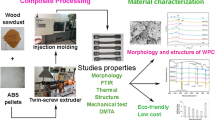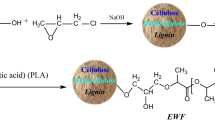Abstract
For evaluation of the rheological and mechanical properties of highly filled wood plastic composites (WPCs), polypropylene/polyethylene (PP/PE) blends were grafted with maleic anhydride (MAH) to enhance the interfacial adhesion between wood fiber and matrix. WPCs were prepared from wood fiber up to 60 wt.% and modified PP/PE was blended by extrusion. The rheological properties were studied by using dynamic measurement. According to the strain sweep test, the linear viscoelastic region of composites in the melt was determined. The result showed that the storage modulus was independent of the strain at low strain region (<0.1%). The frequency sweep results indicated that all composites exhibited shear thinning behavior, and both the storage modulus and complex viscosity of MAH modified composites were decreased comparing to those unmodified. Flexural properties and impact strength of the prepared WPCs were measured according to the relevant standard specifications. The flexural and impact strength of the manufactured composites significantly increased and reached a maximum when MAH dosage was 1.0 wt.%, whereas the flexural modulus after an initial decreased, also increased with MAH dosage. The increase in mechanical properties indicated that the presence of anhydride groups enhanced the interfacial adhesion between wood fiber and PP/PE blends.
Similar content being viewed by others
References
ASTM D790-03. 2004. Standard test methods for flexural properties of unreinforced and reinforced plastics and electrical insulating materials. Annual Book of ASTM Standards. Conshohocken: ASTM International.
Balasuriya PW, Ye L, Mai YW. 2001. Mechanical properties of wood flake-polyethylene composites. Part 1: effects of processing methods and matrix melt flow behaviour. Composites: Part A, 32: 619–629.
Bengtsson M, Baillif M L, Oksman K. 2007. Extrusion and mechanical properties of highly filled cellulose fibre-polypropylene composites. Composites: Part A, 38: 1922–1931.
Bledzki AK, Reihmane S, Gassan JJ. 1998. Thermoplastics reinforced with wood fillers: a literature review. Polymer Plastic Technology, 37(4):451–468.
Felix JM, Gatenholm P. 1991. The nature of adhesion in composites of modified cellulose fibers and polypropylene. J. Applied Polymer Science, 42:609–620.
GB/T 1043-1993. 1994. Plastics—determination of charpy impact strength of rigid materials. National Standards of PRC. Beijing: State Technical Supervision Bureau, p8. (In Chinese)
Hon DNS, Ren S. 2003. Interfacial phenomena of newspaper fiber reinforced polypropylene composite, Part I: The development of interfacial interaction. J Reinforced Plastics Composites, 22(11): 957–971.
Karmarkar A, Chauhan SS, Modak JM, Chanda M. 2006. Mechanical properties of wood-fiber reinforced polypropylene composites: Effect of a novel compatibilizer with isocyanate functional group. Composites: Part A, 38:227–233.
Karnani R, Krishnan M, Narayan R. 1997. Biofiber-reinforced polypropylene composites. Polymer Engineer Science, 37(2): 476–483.
Lu J Z, Wu Q L, Negulescu I I. 2005. Wood fiber/High Density Polyethylene composites: coupling agent performance. J. Applied Polymer Science, 96:93–102.
Maldas D, Kokta BV. 1993. Role of coupling agents and treatments on the performance of wood fiber thermoplastic composites. In: Walcott M.P., Editor. Wood fibres/polymer composites: fundamental concepts, processes, and material options. USA, Madison: Forest Product Society, 112–120.
Marcovich NE, Reboredo MM, Kenny J, Aranguren MI. 2004. Rheology of particle suspensions in viscoelastic media. Wood flour-polypropylene melt. Rheologica Acta, 43: 293–303.
Nunez AJ, Sturm PC, Kenny JM, Aranguren MI, Marcovich NE, Reboredo M M. 2003. Mechanical characterization of polypropylene wood flour composites. J. Applied Polymer Science, 88: 1420–1428.
Oksman K, Clemons C. 1998. Effects of elastomers and coupling agent on impact performance of wood flour filled polypropylene. J Applied Polymer Science, 67(9): 1503–1513.
Zadorecki P, Michell AJ. 1989. Future prospects for wood cellulose as reinforcement in organic polymer composites. Polymer Composites, 10(2):69–77.
Author information
Authors and Affiliations
Corresponding author
Rights and permissions
About this article
Cite this article
Gao, H., Song, Ym., Wang, Qw. et al. Rheological and mechanical properties of wood fiber-PP/PE blend composites. Journal of Forestry Research 19, 315–318 (2008). https://doi.org/10.1007/s11676-008-0057-9
Received:
Accepted:
Published:
Issue Date:
DOI: https://doi.org/10.1007/s11676-008-0057-9




